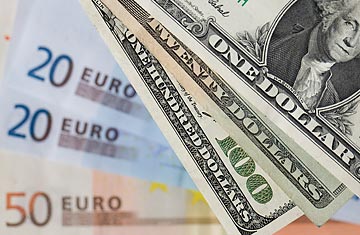
After years of watching Europe's single currency appreciate against the U.S. dollar, European companies are rubbing their hands at the sales boost they should get from the euro's 10% decline against the greenback in recent weeks — a slide that may not yet be over. "After so much protest about the strong euro, I know there are big French exporters out there who aren't unhappy seeing it where it is now," French Economy Minister Christine Lagarde told Europe 1 radio in late February, just days before the euro's exchange rate to the dollar dropped another cent, to a nine-month low of $1.34.
New statistics released Thursday, March 4, show that growth in the euro zone in the last quarter of 2009 was an anemic 0.1%. But it would have been far worse had euro-zone exports not surged 1.7%. Domestic consumer spending — which has been the main growth motor in Europe over the past year — was virtually flat, while business investment dropped 0.8%. That export activity occurred prior to the recent drop in the euro's value against the dollar. Given that fall, many European exporters hope their increasingly affordable products will start flying off shelves. The reason: beyond its recent drop, some analysts expect the euro to weaken further as markets — assuming that Greece's apparently successful bond issue this week signaled that the worst of that crisis is over — turn their sights to the troubled finances of Italy, Portugal and Spain.
That would be good for European exporters — and economies. The lion's share of euro-zone exports are sold by small and medium-size companies that constitute the largest generators of employment across Europe. Germany — far and away the euro zone's largest exporter, and the second biggest worldwide — in particular is likely to benefit. "This is a very positive development for all companies in the euro zone who, like us, really feel the effects when the rates rise above the $1.25-to-$1.30 range," says Philippe Lafaure, president of LCL Technology, a Toulouse-based producer of wireless embedded electronic systems that does about 90% of its sales in exports. "In the end, a lower euro translates into lower prices, which is good for our business and all exporting companies in the euro zone."
But the debt-provoked currency plunge won't be a miracle cure for the economic ills of all euro-zone exporters. Lafaure, for example, notes that while his euro costs in research and development greatly affect sales price, his company is partly protected by having production sites in dollar-zone countries in Asia — providing a pricing hedge when the euro is too high. Multinationals with affiliates in the dollar zone have benefited from the weaker dollar over the past few years. German electronics giant Siemens, for example, generated nearly 45% of its revenue in 2009 in the dollar region. "The bigger the company is, the less traditional export activity it tends to do and the less exposed it is to currency fluctuations," says Siemens spokesman Wolfram Trost. "But when applied to an entire export-driven country like Germany, a drop in the value of the euro becomes a very significant and positive development."
It's been a long time coming. For much of the past five years, the euro has floated between $1.45 and $1.55, in large part due to U.S. policies aimed at keeping the dollar undervalued so dollar-priced American exports would be more affordable abroad. Debt-spooked markets are now reversing that — something that could over time take the currency closer to the $1.15-to-$1.20 range that experts say is its true value. "The return to a euro-dollar balance of under $1.30 by the end of the year now seems possible," French bank BNP Paribas recently reported. Of course, those bargain American vacations Europeans have become used to taking just got a lot more expensive.
